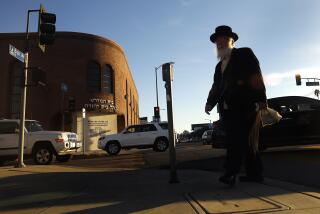Churches Anchor Communities
- Share via
Time was, no one much minded living next to a house of worship. It was quieter than sharing the block with a brick factory and far more pleasant than a slaughterhouse. Besides, it was an easy walk on Sundays. These days, though, churches, synagogues and mosques often appear about as welcome in some neighborhoods as a Pussycat Theater.
As the Islamic holy month of Ramadan enters its second week, the story of a Granada Hills mosque makes the point that modern suburbanites are far less forgiving of holy places that might trespass against them. The Islamic Center of Northridge got built only after it was slapped with a record 44 restrictions by the Los Angeles City Council. The rules limited everything from design to how many people can attend events. Neighbors feared noise and traffic. And they insisted on an architectural style more Southwestern than Middle Eastern.
Other holy places, from churches in Chatsworth to synagogues in Woodland Hills, have faced tough battles to get building permits. Most offer more than just weekly services--from nightly community meetings to day schools. That means higher impact on surrounding homes. It’s easy to sympathize with a homeowner kept awake by late-night meetings or unable to park on the street. A house of worship quickly becomes just another land use--subject to the same suburban suspicions as a liquor store or a burger joint.
True, a congregation can have tremendous impacts on a neighborhood--but not all of them are bad. Regardless of the faith, these places can add a sense of community to neighborhoods by offering everything from nearby day care to evening classes. They serve as polling places on election days. Looking at them solely as generators of traffic or noise denies their potential as anchors that hold a community in place. On balance, they give as much as they take.
More to Read
Sign up for Essential California
The most important California stories and recommendations in your inbox every morning.
You may occasionally receive promotional content from the Los Angeles Times.










